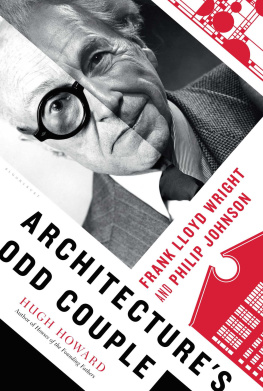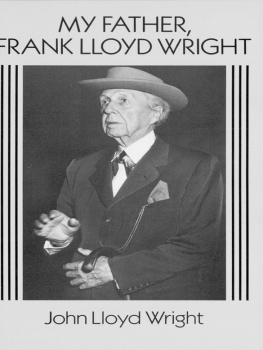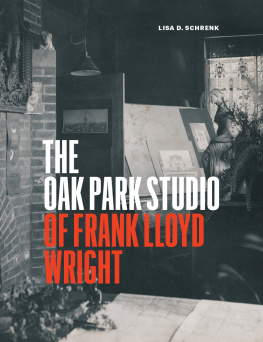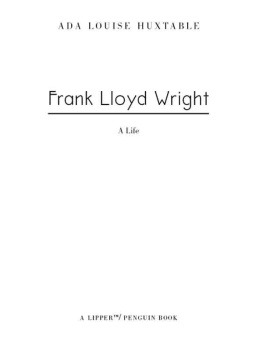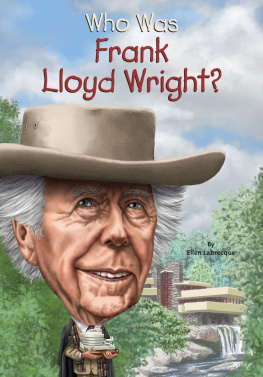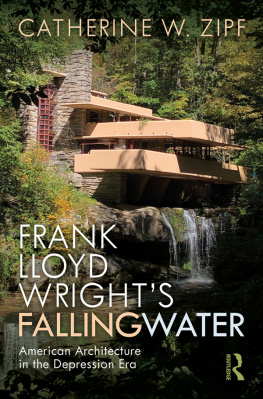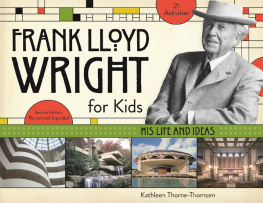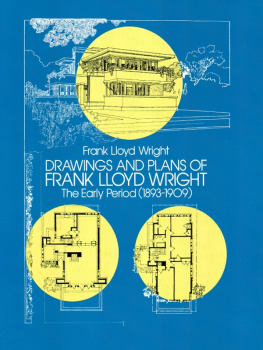For E. L. H.

Each knew that he was in major respects a mirror image of the other, a realization that made it only easier to like, and to distrust, each other.
Franz Schulze,
Philip Johnson: Life and Work (1994)
CONTENTS
You cant have a culture without architecture.
Frank Lloyd Wright
September 20, 1955 New Haven, Connecticut Union Station
A man wearing a cape and porkpie hat stepped off the train. Scanning the platform, he saw not so much as a raised hand to acknowledge his arrival. No one approached to offer respectful words of greeting.
This was unexpected.
Frank Lloyd Wrights face had graced the cover of Time magazine. Cabdrivers in Manhattan knew him on sight and hung on his every word. It was generally accepted that Ayn Rand had based the central character of her bestselling novel The Fountainhead on Mr. Wright. NBC had recently broadcast his black-and-white visage into Americas living rooms on the popular television show Conversations with Elder Wise Men. In an era when fame was meted out in small doses, his outspoken opinions and an innate gift for attracting the public eye made Wright the only architect with a name widely recognized at the American supper table.
Yet on this day in New Haven, despite having been booked as the headliner for the inaugural event in Yales Perspectives series, the eighty-eight-year-old Wright made his way from trackside by himself.
No apprentice waited on him, as one would have done at Taliesin, his home in Spring Green, Wisconsin (constructed in 1911), or at Taliesin West (constructed in 1937), the winter quarters of his school-cum-architecture practice in Scottsdale, Arizona. At his latest place of residence, his second-floor suite at the Plaza Hotel (dubbed, inevitably, Taliesin East), his arrival would have caused one or two or five acolytes to rise, to lift his bag, to seek the Masters approval.
Just last year the great university a few blocks away had bestowed upon him the honorary degree of doctor of fine arts. But Wright seemed to be the forgotten man as he emerged from the bowels of the New Haven rail station. All 609 seats in Room 114 were booked for the nine P.M. event at Strathcona Hall, and the events organizers, the Yale Daily News and Yale Broadcasting Company, expected a great clamor. They were delighted at what seemed likely to be a standing-room-only crowd.
Still, Wright remained alone as he entered the great waiting room. On another day, he would have paused to critique Union Station, a Beaux Arts exercise of the late Cass Gilbert. Called by some the vestibule of the city, the space was brightly lit by the midday sunlight pouring in from the ten towering, semicircular windows that lined the thirty-five-foot-tall walls of polished white limestone. Wright could not approve, of course; he had spent decades decrying the application of Roman and Greek details to contemporary buildings. In the presence of a suitable audience, he might have waved his rubber-tipped cane, pointing out the dishonesty of using fenestration from the age of Diocletian two millennia too late. But it seemed that no one knew or cared what he had to say.
Seething with anger, Wright settled on a solution.
He moved deliberately toward the ticket windows. If no one could be bothered to greet him, he saw no need to stay. He would simply climb aboard the next southbound train and return to Manhattan.
In that moment of resolution, Mr. Wright also knew whom to blame. That would be Philip Johnson, the man he knew best here in New Haven. After all, a few months ago, at another of the Iviesat Harvard, no lessthe younger man had cruelly and publicly dismissed him as the greatest architect of the nineteenth century.
On this particular September day, the forty-nine-year-old Philip Cortelyou Johnson drove himself to New Haven, as he ordinarily did twice a week during term time.
A few years before, he had established his base of operations in nearby New Canaan, Connecticut, setting up shop on the second floor at 89 Main Street. He shared architectural offices with a small and varying staff that consisted of a draftsman or two and a part-time secretary. Though it overlooked the villages busy main intersection, Johnsons place of business was austere, characterized by its absolute order. All clutter, from drawings to drafting pencils, was banished to the many cupboards and drawers.
Johnson liked New Canaan, which Its convenience to Manhattan, an hours drive southwest, enabled him to continue his on-again, off-again curatorial labors under the aegis of his closest friend, Alfred Barr, at the Museum of Modern Art (MoMA). There, in 1932, Johnsons first curatorial effort, Modern Architecture: International Exhibition, had established his reputation. That show also led to his firstand rather problematicexchange with Frank Lloyd Wright.
While his architectural practice now showed genuine signs of keeping the hyperactive Johnson fully occupied, for the preceding half decade New Canaan had offered him both a respite from Manhattan and access to yet another career, since New Haven and its famed university were an easy, easterly meander along the coastal road overlooking Long Island Sound.
At Yale, Johnsons work as a New York curator and New Canaan architect took a backseat to his role as pedagogue. He had found a not-quite-professorial place within the university structure, functioning as a critic-in-residence at the School of Architecture. As at MoMA, he took no pay from Yale. Independently wealthy, Johnson could afford a need-blind approach to such jobs, and he reveled in the accompanying sense of independence.
He delighted in talking about design and buildings; his joy in architecture was infectious. Johnson possessed a fast-firing critical mind, and though he respected the disciplines of the lecture hall and design studios in New Haven, his candor and humor also meant his aphoristic tongue could shock and even offend people. For the students, his sometimes impolitic remarks and sharp critical assessments only enhanced his standing. He could and did say what he liked, and as one of his brightest Yale pupils, Robert A. M.
Johnson liked nothing better than to schmooze and amuse, and the neutral territory of the Yale School of Architecture suited him. He had earned his architecture degree at Harvard, but he could hardly have allied himself with its Graduate School of Design. Johnson had conspicuously avoided architecture department chairman Walter Gropius as he earned his architecture degree during the war years. (Their disconnect was personal and professional; Johnson admitted to liking neither the man nor his work.) Johnson cultivated mentors and friends in Cambridge, but many of them, including Gropiuss old Bauhaus colleague Marcel Breuer, had since established peacetime practices in New York. Several of those, including both Breuer and John M. Johansen, had built homes in New Canaan. Together with Johnson, their cohort had established a Modernist bastion in what had been a predominantly clapboard New England town. They built houses of steel and glass, unadorned and geometric.
Although Yales program still remained in the shadow of Harvards (thus far, it granted only baccalaureate degrees), Johnson recognized the emerging talent there would soon bring it to the forefront. The regular faculty included architect Louis Kahn and a young architectural historian named Vincent But landing Wright to lead an evening forum was something of a coup.
Yale had treated Johnson well. Just the preceding January, an exhibition of his works had been installed at the Yale Art Gallery, featuring models, mural-size photographs, and stereopticon slides of his work. Mounted by a recent graduate from the Yale School of Architecture who worked as an associate in Johnsons office, the little show had been a happy inversion for Johnson, usually the curator rather than the curated. Central to the show had been his most notable and, to some, his most notorious design.
Next page
